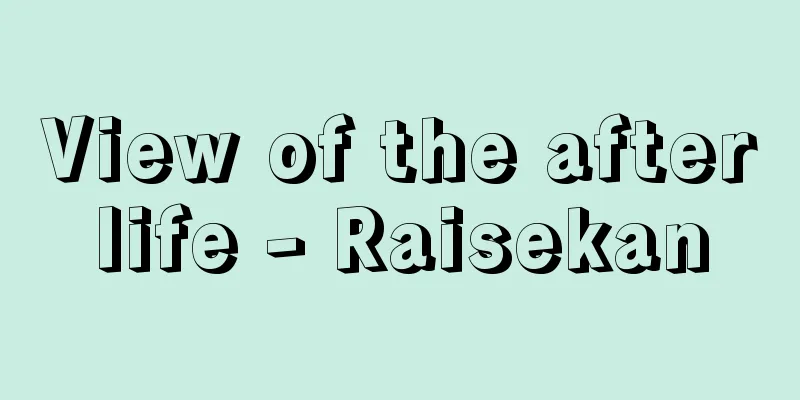View of the afterlife - Raisekan

|
In a broader sense, it can refer to the idea of another world in general, just like the idea of the afterlife, but more narrowly it means the idea of the world in which humans live after death. In this case, the idea of the afterlife is one form of the idea of the afterlife. Primitive religions also have a concept of the world in which the dead live, but it is not related to the consideration of the fate of individuals after death, as in the concept of the afterlife. Personal consideration of the afterlife arises together with the concept of the individual's fate. Thus, the concept of the afterlife first took a clear form in ancient civilizations, where a sense of history and a sense of the individual as a distinguished individual arose. The concept of the afterlife in ancient religions was not that of the masses, but is seen in the style of funerals for kings and nobles. Their tombs were filled with the consideration of continuing their privileged existence as individuals after death. It was believed that mummies, huge tombs, their luxurious decorations, and personal possessions such as grave goods and martyrs would protect and enrich their existence in the afterlife. There, worldly values were simply affirmed, and it was hoped that these values would continue after death. In the ancient religious view of life and death, this world and the afterlife were given equal weight, and the central concept of the afterlife was the concept of immortality. It was only in historical religions that the idea of the afterlife became popular and became a powerful principle regulating ethics in this world. In Indian religions, including Buddhism, the idea of reincarnation was established, which states that after death, people will live various lives in an afterlife that is qualitatively equal to this world, depending on the goodness or evil of their actions in this world (karma). In contrast, Mahayana Buddhism emphasized the idea of hell and the Pure Land, which are afterlives separated from this world, linked to the idea of a savior. A representative example is the idea of rebirth in the Western Pure Land of Amida Buddha, in which people believed that they would go to the Pure Land or hell after death depending on their good deeds and the depth of their faith in this world. In Christianity, an eschatological view of history was combined with a view of the afterlife. In other words, after the second coming of Christ, all the dead will be brought to the judgment table and assigned to heaven or hell. Islam also has a similar idea of the final judgment. In Christianity and Islam, there is also the idea of a world intermediate between heaven and hell (purgatory or limbo). The idea that one's fate in the afterlife is decided by judgment is also seen in ancient religions, but in historical religions it is an equal ethical judgment for all human beings. This view of the afterlife is particularly easy for the masses to accept among the teachings of historical religions, and a mythical view of the afterlife accompanied by concrete images was naively believed in. In historical religions, the afterlife is the center of time and space, and one's fate after death is considered to be far more important than that of this world. In contrast to the immortality of ancient religions, the idea of rebirth can be said to be central to the view of the afterlife here. In modern religions (such as Protestantism), which are modern transformations of historical religions, the simple belief in an afterlife has been weakened by demythologization, and the aim has been to construct a present-world ethics that rejects any consideration of the afterlife, as seen in Calvin's doctrine of predestination. The new religious movements that have arisen around the world in modern times are more thorough in their focus on this world. In particular, new religions in Japan place emphasis on the fulfillment of life activities in this world and do not pay much attention to fate after death, but it is common to believe that after death humans will merge with the fundamental life that permeates the universe (such as God the Parent or Buddha), and will then manifest as various individual lives. Here, the idea of an afterlife has been replaced by the idea of permanent development and expansion of life in this world. [Shimazono Susumu] [References] | | |Source: Shogakukan Encyclopedia Nipponica About Encyclopedia Nipponica Information | Legend |
|
広くは他界観と同様、別世界一般についての観念をもさすが、狭くは人間が死後に住む世界に関する観念を意味する。この場合、来世観は他界観の一様式である。 原始宗教にも死者の住む世界についての観念はあるが、それは来世観のように個々人の死後の運命への顧慮と関連したものではない。死後への個人的顧慮は個人の運命という観念とともに発生する。したがって来世観は、歴史意識や卓越した個人という意識が生じる古代文明において初めて明確な形をとる。古代宗教における来世観は大衆のものではなく、王侯や貴族の葬送の様式にうかがえるものである。彼らの墳墓は、死後も個人として特権的な存在を続けようとする顧慮に満ちている。ミイラ、巨大な墳墓、その豪華な装飾、副葬品や殉教者などの私財は、彼らの来世の存在を保護し、豊かにするものと信じられた。そこでは現世的諸価値が素朴に肯定されており、そうした価値の死後への継続が願われている。古代宗教の生死観では現世と来世は同等の重さをもっており、来世観の中心は不死の観念だったのである。 歴史宗教において初めて来世観は大衆のものになり、現世の倫理を規制する強力な原理となる。仏教をはじめとするインド宗教では、死後、現世での行為の善悪(業(ごう))に応じて、現世と質的に等しい来世でさまざまな生を送るという輪廻(りんね)の観念が成立した。これに対して大乗仏教では、救済者の観念と結び付いて現世と断絶した来世である地獄や浄土の観念が強調された。代表的なのは阿弥陀(あみだ)仏の西方極楽浄土への往生(おうじょう)の思想で、現世での善行や信仰の深さによって死後、浄土または地獄へ行くと信じられた。キリスト教では、終末論的な歴史観と他界観との結合が行われた。すなわち、キリストの再臨後すべての死者が審判の場に引き出され、天国と地獄に振り分けられるとするのである。イスラム教にも同じような最後の審判についての観念がある。キリスト教やイスラム教では、さらに天国や地獄の中間の世界(煉獄(れんごく)・リンボ)が考えられている。来世の運命は審判によって決定されるという観念は古代宗教にもみられるが、歴史宗教のそれはすべての人間に対する平等な倫理的審判となっている。こうした来世観は歴史宗教の教えのなかでもとくに民衆に受け入れられやすいもので、具体的なイメージを伴った神話的来世観が素朴に信じられていた。歴史宗教では来世に時間や空間の中心があり、死後の運命は現世の運命よりはるかに重いものとされた。古代宗教の不死に対して、ここでは再生という観念が来世観の中心であるといえよう。 歴史宗教の近代的な変容形態である近代宗教(プロテスタンティズムなど)では、非神話化によって素朴な来世信仰が弱められ、カルバンの予定説にみられるように、来世への顧慮を拒否した現世的倫理の構築が目ざされた。現世への関心集中という点でより徹底しているのは、近・現代に世界各地で起こった新宗教運動である。とくに日本の新宗教では現世における生命活動の充実が重視され、死後の運命にはあまり顧慮を払わないが、死後人間は宇宙に行き渡る根源的生命(親神・仏など)に融合し、さらにまたさまざまな個別的生命として発現すると信じる見方が一般的である。ここでは来世観が、生命の現世内における永続的発展・拡充の観念にとってかわられているのである。 [島薗 進] [参照項目] | | |出典 小学館 日本大百科全書(ニッポニカ)日本大百科全書(ニッポニカ)について 情報 | 凡例 |
<<: Licensed production - Licensed production
Recommend
Kono Michiari
Year of death: 14th July 1311 (28th August 1311) Y...
Printed pattern - Inkamon
A decorative technique for ceramics, in which patt...
Umadashi - Umadashi
〘noun〙① A place in the riding arena where horses a...
Akaeshiki pottery
A painting method used on ancient Greek pottery. I...
Levi
French orientalist. He studied Sanskrit at the Uni...
Cicca
…In China and Japan, candles are made from the Ch...
Outer ring - Sotowa
〘noun〙① The state of pointing one's toes outwa...
Legal Socialism
A position that seeks to realize the ideal of soci...
Tinctoris, J.
... Composition refers to the process in which th...
Menthiafolin
…It is distributed from Hokkaido to Kyushu, and a...
Trial cut - Trial cut
During the Edo period, a sword was tested for its ...
Stock issues to shareholder
A type of capital increase in which a corporation...
Gregory XIII
1502‐85 Pope of the Roman Empire. Reigned 1572-85....
Fishing machinery
...Fish traps set up in rivers are also a type of...
Q cult - Kyukyodan
…This process of evangelization largely coincides...









